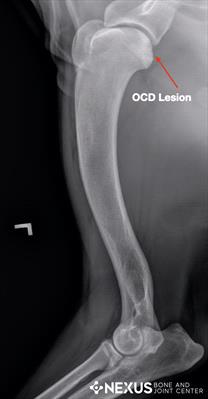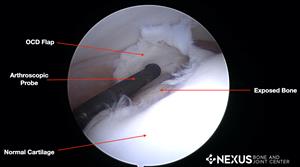OCD_Radiograph

This radiograph shows an OCD lesion in the joint. Photo courtesy of Dr. David Dycus.
If your adolescent puppy becomes lame or stiff when rising or after play on one or more legs, there are several possible reasons for it. One reason is a disease called osteochondritis dissecans (OCD). OCD negatively impacts the cartilage in certain joints. Cartilage is connective tissue that provides cushioning on the joint surface to soften the impact when walking and running. When the cartilage is damaged, the joint cannot function properly; discomfort and pain become lasting effects.
OCD is a condition where a cartilage flap forms during development. This flap will induce a painful inflammatory response within the joint. In some situations, the flap separates, floating uselessly around the inside of the joint and causing pain and further destruction to the joint.
OCD is most commonly seen in the shoulder, but can also be seen in the knee, elbow, and ankle joints. OCD causes differing levels of pain and lameness, making it hard for your young dog to be active.
Generally speaking, OCD is a developmental disease seen in rapidly growing puppies of some but not all large breeds, including Great Danes, Bernese Mountain Dogs, Golden Retrievers, and German Shepherds. Some breeds are more likely to have it than others. It's typically a disease of adolescence with onset often seen around the age of 4 to 9 months. In people, it is usually seen in children and adolescents. OCD is seen far more often in male dogs than females.
If your dog is stiff and sore after rising or heavy play, or is lame, it's best to see the veterinarian as early as possible. Typically, when a lameness is noted in a young dog with an OCD lesion (the entire area affected), the lesion is chronic and warrants immediate treatment.
Causes
No one really knows what causes OCD, although various factors can contribute. A hereditary component is suspected in most dogs, especially Newfoundlands. Before you buy a puppy, ask your breeder specifically if the puppy's parents have OCD. In general, it is considered multi-factorial in that a combination of factors contribute to it.
Along with genetics, diet also plays a role; in particular, puppies whose diet has too much calcium or vitamin D. Supplementation should be avoided in puppies. In addition, any effort to make the dog grow as big as possible as quickly as possible should be avoided. It's healthiest to let the dog grow to the size nature intended without any dietary interference.
Other potential causes of OCD include injury, lack of blood flow and hormonal issues.
Signs
Dogs will initially show stiffness and soreness when rising or after heavy play. Overtime, this will turn into a limp in the affected leg or legs because they avoid bearing weight on a painful leg. If you press on that sore area, the dog may cry. Sometimes an affected joint is warm and swollen.
Lameness is a sign of pain. An OCD lesion can either be constant or once in a while.
Diagnosis
Most dogs are taken to the veterinarian because they are stiff after rising or play or are lame in at least one leg. Various causes of stiffness and lameness can occur in the joints of developing dogs. Diseases and problems such as elbow dysplasia, patella (kneecap) luxation, and growth plate fractures can have similar signs as an OCD lesion. A thorough orthopedic examination and imaging should be performed by your veterinarian for a diagnosis and to rule out other diseases.
Radiographs (X-rays) should always be taken in a lame growing dog. Oftentimes sedation is needed because specific positioning is necessary, and several images must be taken. Radiographs are a great screening tool, but an OCD lesion is not always seen. In some cases, your veterinarian may prefer that the X-rays be reviewed by a veterinary radiologist. If there is a high suspicion of an OCD lesion, your veterinarian may recommend a CT scan or even an arthroscopy evaluation. A CT scan allows veterinarians to view the bone in more of a three-dimensional manner while an arthroscopic examination involves inserting a small video camera into the joint. This allows direct visualization and treatment of an OCD lesion.
Treatment
Obviously, treatment depends on severity of the OCD lesion. Conservative management is only recommended for dogs less than 6 months of age with minimal clinical signs and no overt radiographic changes. Conservative management may consist of pain medications, exercise restriction, dietary changes, and formal rehabilitation therapy.
OCD_Arthrsoscopy

Arthroscopic surgery, as shown here, is the gold standard for OCD treatment. Photo courtesy of Dr. David Dycus.
For any dog over the age of 6 months, conservative management of an OCD lesion is likely to be ineffective. Surgery is indicated to remove the cartilage flap and to stimulate the underlying bone bed to form scar tissue (fibrocartilage). In some cases with large lesions, an artificial plug may be inserted into the bone bed. Arthroscopic surgery is the gold standard for OCD treatment given the minimally invasive nature, better visualization, and quicker recovery. Total recovery time is about 8-12 weeks of exercise restriction to avoid running, jumping, and playing. The first 2 weeks after surgery activity is restricted to short, leashed walks - basically just enough for the dog to relieve themselves along with passive range of motion exercises. Beginning 2 weeks after surgery, a structured daily leash walking program and home exercise plan are begun along with formal rehabilitation guided by a rehabilitation therapist.
Prognosis
The earlier the problem is dealt with, the better the prognosis is. Any stiffness or lameness in a puppy warrants immediate evaluation by your veterinarian. More times than not, the stiffness or lameness may not be anything significant. However, the earlier your veterinarian can diagnosis the problem and recommended surgery, the better off your dog's recovery will be.
Your dog's prognosis depends on which joint or joints are affected, and how severely. Prognosis for full recovery is good if only the shoulder is affected. Other joint involvement has a more guarded prognosis, meaning progression of arthritis as well as possible periods of intermittent lameness.
Keeping your dog at a healthy weight helps keep the joints working properly. Your veterinarian can help you help your dog lose weight if that would be beneficial.